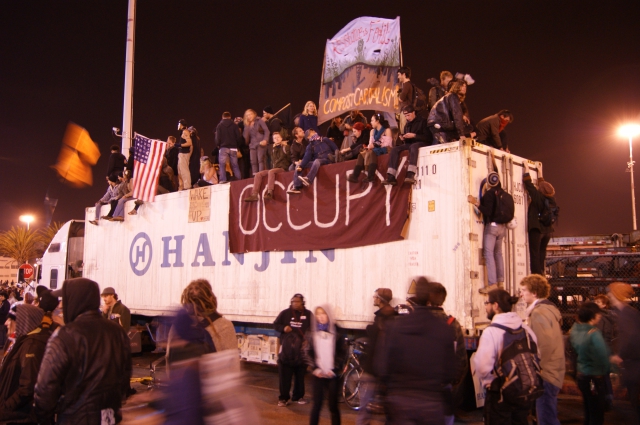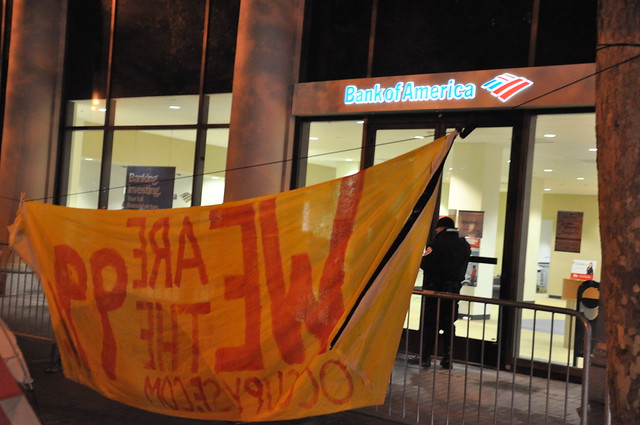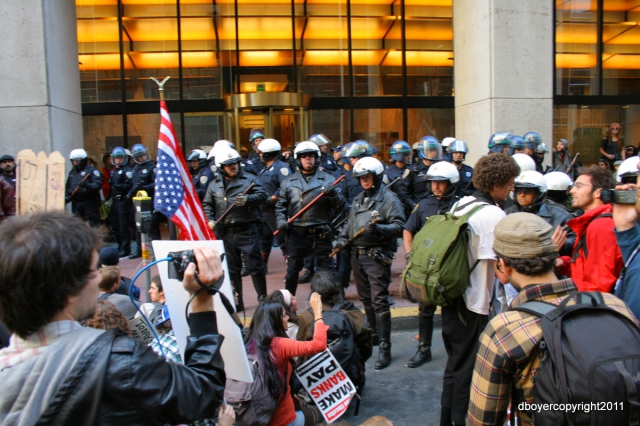I get to work via the casual carpool. For those who are unfamiliar with this Bay Area institution, it’s a way of traveling to work cheaply and usually fast. Riders line up near transbay bus stops, and drivers come by and pick up one or two passengers so they can go through the carpool lane – a carpool is defined as three or more, unless you have a two-seater. If there are more riders than cars, most drivers will gladly take a third passenger. Carpools used to go over the bridge toll-free, but now they pay $2.50 (the normal rush-hour toll is $6), so each rider pays $1. If the driver picks up three people, they make 50 cents on the deal. At my stop, it’s very changeable; some days there’s a long line of cars waiting for riders, others a long line of riders waiting for rides. Two or three times in the last year, I’ve ended up taking the bus. I’ve never heard of anyone being assaulted or harassed while riding the carpools.
The other day, I rode with a woman and a man, and as we made our way to the Bridge, they started talking about their kids. The guy’s kids were late elementary schoolers, and the woman’s were in middle and high school. The guy said he was lucky, that his kids liked school and didn’t mind doing their homework. The woman said two of hers were good students, but her oldest son – “Well, thank God there are garbage men jobs for people like him.”
Though of course there is nothing wrong with being a garbage man, and anyway it’s probably not nearly as easy to get those jobs as she thinks, I was upset that she was so dismissive of her son. It hit on something I’ve been thinking about a lot, how school so often seems to kill kids’ enthusiasm and curiosity instead of fostering it.
“There must be something,” I started to say and she cut me off.
“There’s nothing wrong with him. I thought he had ADHD, but I had him tested and he’s fine. He’s just lazy.”
Undeterred, I said, “What is he interested in?”
“You mean his hobbies?”
“Yes.”
“Skateboarding,” she said. “He and his friends spend hours out in the street, practicing their tricks. He goes snowboarding every weekend in the winter. His father says he can’t get enough of it.”
“Well maybe he’ll be a snowboarding instructor,” I suggested.
“Could be,” she said. Her voice had softened.
The driver jumped in. “There’s a skate park near where I live,” he said. “The kids were always out there, cutting school. So this guy got an idea, and he started them making videos. He set up an editing studio and taught them how to edit. They ended up learning about story writing, computer skills. Hopefully, it made them realize that there were things they could learn in school that would help them.”
I had actually been thinking of that, because back when I lived in the City and skated to work, I would always pass skateboarders filming each other. They said they made a fair amount of money that way, and that was in the days before YouTube. But his mentioning the skate park gave me another idea.
“They could design a park,” the guy said. “They would have to learn math…”
“Math and design,” I said. “And teamwork, figuring out what they want as a group. But then they could really try to get it built. They’d need to do fundraising, find out about the permitting process and how to get approval from the city. They might need to do some lobbying, and probably community organizing to counter the inevitable opposition from the neighbors. They’d have to figure out how it was going to be run, would they need a nonprofit or some other kind of organization to run it. How would decisions be made about it, how would disputes over who could use it when be mediated, and how would it be maintained?”
I didn’t say but thought that they could run into things like gang injunctions and curfews, and need to make coalitions with the people fighting those.
“They’d probably want to read about how kids in other cities got parks built,” said the driver.
The woman seemed to like the idea, and said she would talk to her son about it. As we got out of the car, it occurred to me that this was probably the first time she ever thought of her son’s talents and interests as anything other than a waste of time. If the idea catches on, it could also be the first time her son thinks of school as anything other than a waste of time.
The other day, I rode with a woman and a man, and as we made our way to the Bridge, they started talking about their kids. The guy’s kids were late elementary schoolers, and the woman’s were in middle and high school. The guy said he was lucky, that his kids liked school and didn’t mind doing their homework. The woman said two of hers were good students, but her oldest son – “Well, thank God there are garbage men jobs for people like him.”
Though of course there is nothing wrong with being a garbage man, and anyway it’s probably not nearly as easy to get those jobs as she thinks, I was upset that she was so dismissive of her son. It hit on something I’ve been thinking about a lot, how school so often seems to kill kids’ enthusiasm and curiosity instead of fostering it.
“There must be something,” I started to say and she cut me off.
“There’s nothing wrong with him. I thought he had ADHD, but I had him tested and he’s fine. He’s just lazy.”
Undeterred, I said, “What is he interested in?”
“You mean his hobbies?”
“Yes.”
“Skateboarding,” she said. “He and his friends spend hours out in the street, practicing their tricks. He goes snowboarding every weekend in the winter. His father says he can’t get enough of it.”
“Well maybe he’ll be a snowboarding instructor,” I suggested.
“Could be,” she said. Her voice had softened.
The driver jumped in. “There’s a skate park near where I live,” he said. “The kids were always out there, cutting school. So this guy got an idea, and he started them making videos. He set up an editing studio and taught them how to edit. They ended up learning about story writing, computer skills. Hopefully, it made them realize that there were things they could learn in school that would help them.”
I had actually been thinking of that, because back when I lived in the City and skated to work, I would always pass skateboarders filming each other. They said they made a fair amount of money that way, and that was in the days before YouTube. But his mentioning the skate park gave me another idea.
“Is there a skate park near where you live?” I asked the woman. Since she had said the kids practiced on the street, I figured the answer was no, and it was. “Well why not suggest they try to make one,” I said.
“Math and design,” I said. “And teamwork, figuring out what they want as a group. But then they could really try to get it built. They’d need to do fundraising, find out about the permitting process and how to get approval from the city. They might need to do some lobbying, and probably community organizing to counter the inevitable opposition from the neighbors. They’d have to figure out how it was going to be run, would they need a nonprofit or some other kind of organization to run it. How would decisions be made about it, how would disputes over who could use it when be mediated, and how would it be maintained?”
I didn’t say but thought that they could run into things like gang injunctions and curfews, and need to make coalitions with the people fighting those.
“They’d probably want to read about how kids in other cities got parks built,” said the driver.
The woman seemed to like the idea, and said she would talk to her son about it. As we got out of the car, it occurred to me that this was probably the first time she ever thought of her son’s talents and interests as anything other than a waste of time. If the idea catches on, it could also be the first time her son thinks of school as anything other than a waste of time.








